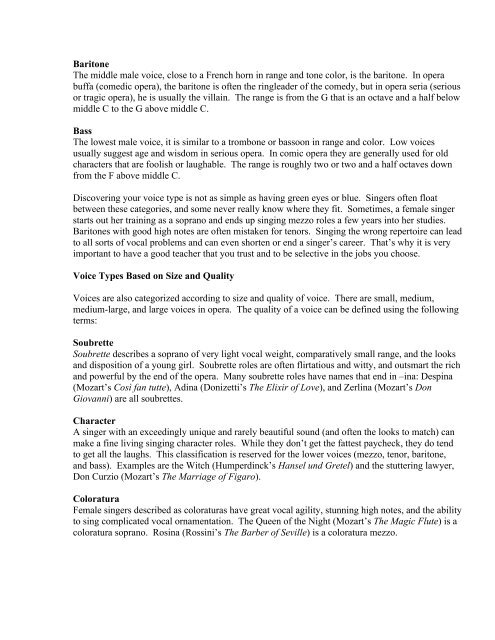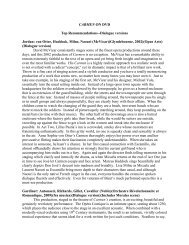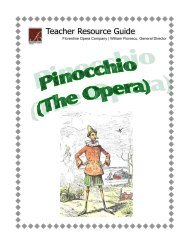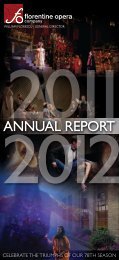Opera In The Know - Florentine Opera
Opera In The Know - Florentine Opera
Opera In The Know - Florentine Opera
Create successful ePaper yourself
Turn your PDF publications into a flip-book with our unique Google optimized e-Paper software.
Baritone<br />
<strong>The</strong> middle male voice, close to a French horn in range and tone color, is the baritone. <strong>In</strong> opera<br />
buffa (comedic opera), the baritone is often the ringleader of the comedy, but in opera seria (serious<br />
or tragic opera), he is usually the villain. <strong>The</strong> range is from the G that is an octave and a half below<br />
middle C to the G above middle C.<br />
Bass<br />
<strong>The</strong> lowest male voice, it is similar to a trombone or bassoon in range and color. Low voices<br />
usually suggest age and wisdom in serious opera. <strong>In</strong> comic opera they are generally used for old<br />
characters that are foolish or laughable. <strong>The</strong> range is roughly two or two and a half octaves down<br />
from the F above middle C.<br />
Discovering your voice type is not as simple as having green eyes or blue. Singers often float<br />
between these categories, and some never really know where they fit. Sometimes, a female singer<br />
starts out her training as a soprano and ends up singing mezzo roles a few years into her studies.<br />
Baritones with good high notes are often mistaken for tenors. Singing the wrong repertoire can lead<br />
to all sorts of vocal problems and can even shorten or end a singer’s career. That’s why it is very<br />
important to have a good teacher that you trust and to be selective in the jobs you choose.<br />
Voice Types Based on Size and Quality<br />
Voices are also categorized according to size and quality of voice. <strong>The</strong>re are small, medium,<br />
medium-large, and large voices in opera. <strong>The</strong> quality of a voice can be defined using the following<br />
terms:<br />
Soubrette<br />
Soubrette describes a soprano of very light vocal weight, comparatively small range, and the looks<br />
and disposition of a young girl. Soubrette roles are often flirtatious and witty, and outsmart the rich<br />
and powerful by the end of the opera. Many soubrette roles have names that end in –ina: Despina<br />
(Mozart’s Così fan tutte), Adina (Donizetti’s <strong>The</strong> Elixir of Love), and Zerlina (Mozart’s Don<br />
Giovanni) are all soubrettes.<br />
Character<br />
A singer with an exceedingly unique and rarely beautiful sound (and often the looks to match) can<br />
make a fine living singing character roles. While they don’t get the fattest paycheck, they do tend<br />
to get all the laughs. This classification is reserved for the lower voices (mezzo, tenor, baritone,<br />
and bass). Examples are the Witch (Humperdinck’s Hansel und Gretel) and the stuttering lawyer,<br />
Don Curzio (Mozart’s <strong>The</strong> Marriage of Figaro).<br />
Coloratura<br />
Female singers described as coloraturas have great vocal agility, stunning high notes, and the ability<br />
to sing complicated vocal ornamentation. <strong>The</strong> Queen of the Night (Mozart’s <strong>The</strong> Magic Flute) is a<br />
coloratura soprano. Rosina (Rossini’s <strong>The</strong> Barber of Seville) is a coloratura mezzo.








